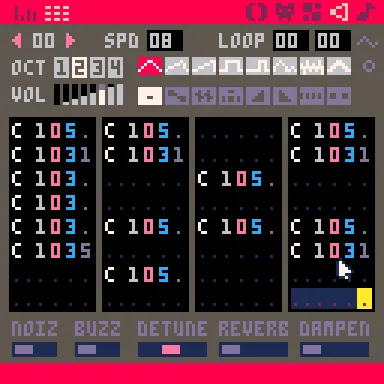I wrote a lot of songs in PICO-8 over the last two years. Not long enough to call myself an expert, but long enough to no longer call myself a beginner. I thought I’d take some time to write down some of the things I’ve learned—techniques that have helped me get the kind of sound I want out of the PICO-8 tracker.
These techniques are not broad enough to qualify as general songwriting advice, but not specific enough to act as a tutorial for someone still figuring out how to use the tools. But if you’re in a similar part of your learning journey to me, I hope you find them useful to you as well.
Brighter waveforms need less volume
If you open up the SFX editor and start writing music without changing anything, you’ll get samples using the triangle wave at volume 5. I think this is a little louder than you need for background music, but in general it sounds fine. Switch over to the square or sawtooth wave though, and at least to my ears, it sounds really harsh. So much so that for my first couple songs, I shied away from using those waveforms at all!
Square and sawtooth waves can sound musical though, they just need a little less volume. Those waveforms have a lot stronger overtones than the smoother waves, so you don’t need to set them as loud for them to stand out. Try a base volume of 3 or 4, and reserve 5, 6 and 7 for when you really want to accent a note.
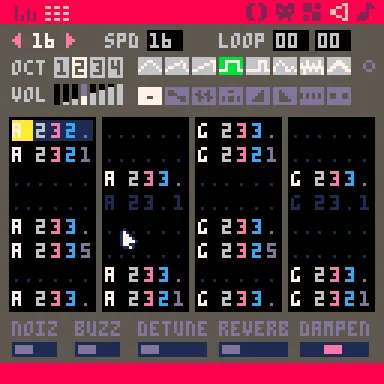
For drum parts, vary pitch instead of volume
I like to use the noise waveform to write drum parts, but I’ve found that getting good sounding drums is tough. One difficulty is that there are only 7 levels of volume. I often wish I could set the volume to something in between (for example) 2 and 3 in order to get nice phrasing without the part getting too loud or too quiet.
Luckily, there’s a way to get more variation: change the pitch instead of volume, or combine both approaches. Higher pitches seem louder even when they’re at the same volume, so you can increase the pitch to create subtle accents in your drum parts without raising the volume too much.
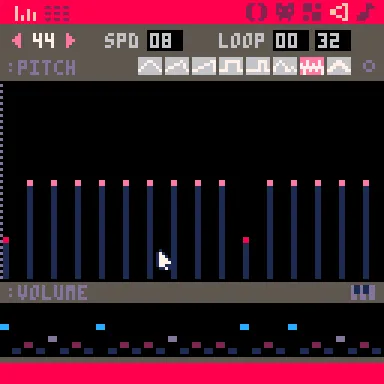
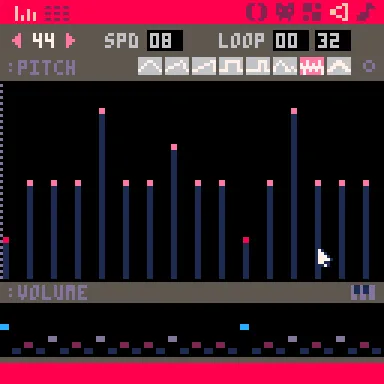
Left: a drum track with no pitch variation.
Right: a drum track that varies the pitch to add accents to some beats.
Use the slide effect for smooth volume changes
The slide effect is a nice way to add some articulation to a melody. You can use it to “bend” between pitches. I used to think that was all it was for, but it turns out it’s also very useful for making notes change volume smoothly. In fact, that’s probably the primary way I use it now.
I like to vary the volume on notes starting with a louder attack on the first sample, then dropping to a lower volume for the sustain — like an ADSR envelope on a synthesizer. The sudden change in volume is quite noticeable, especially at slower tempos. It can sound like the note is being re-struck. The slide effect smooths out the volume change.
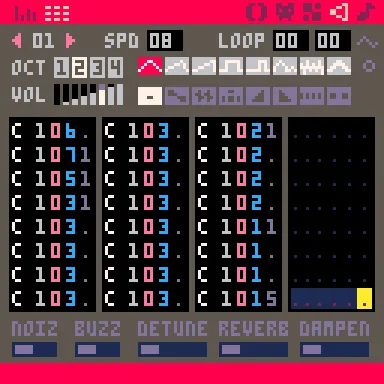
Use the vibrato in the middle of notes
When I use the vibrato effect, I like to add it to the middle of a note. That is, let the first sample or two play with no vibrato, and let the last sample or two play with no vibrato. To me, it sounds more musical that way. It matches the way a singer would sing it.
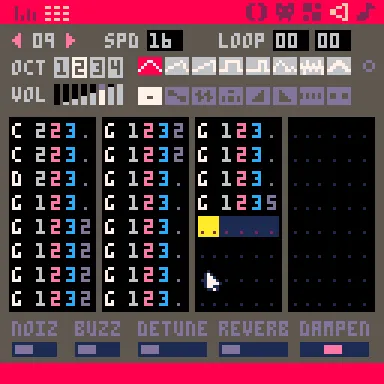
Use the detune filter for power chords and octaves
The detune filter has some cool effects depending on what waveform you’re using. I like to use it with the triangle wave to get power chords. In general, it’s a good way to make harmonies and accompaniment parts sound fuller without using multiple sound channels.
Here are what the different waveforms sound like to me with the detune filter applied:
Detune level 1
- triangle - sounds like note + fourth below
- tilted saw - sounds like a chorus effect
- sawtooth - sounds like a chorus effect
- square - sounds like a chorus effect
- pulse - sounds like a chorus effect
- organ - sounds like a chorus effect
- noise - still sounds like noise
- phaser - sounds out of tune (almost like the note + semitone above)
Detune level 2
- triangle - sounds like note + fifth above
- tilted saw - sounds like note + octave above
- saw - sounds like note + octave above
- square - sounds like note + octave above
- pulse - sounds like note + octave above
- organ - sounds like note + octave above
- noise - still sounds like noise
- phaser - sounds like note + octave above
When I first started writing music in PICO-8, the limit of 4 sound channels felt very constraining. I’m used to writing music for piano or guitar, where playing chords with 4, 5, 6 or more notes is normal, so it was a happy discovery when I found out that I could get some basic harmony out of a single channel by detuning it.
